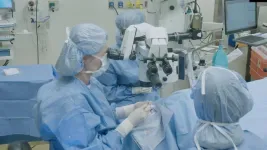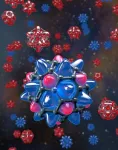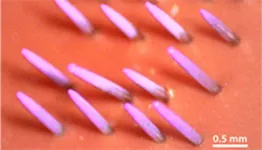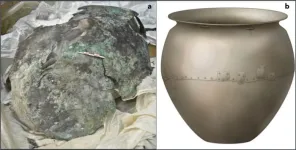(Press-News.org) BOSTON– A team led by researchers from Mass Eye and Ear, a member of Mass General Brigham, reports the results of a phase I trial of a revolutionary stem cell treatment called cultivated autologous limbal epithelial cell transplantation (CALEC), which was found to be safe and well-tolerated over the short term in four patients with significant chemical burns in one eye. According to the study published August 18 in Science Advances, the patients who were followed for 12 months experienced restored cornea surfaces — two were able to undergo a corneal transplant and two reported significant improvements in vision without additional treatment.
While the phase I study was designed to determine preliminary safety and feasibility before advancing to a second phase of the trial, the researchers consider the early findings promising.
“Our early results suggest that CALEC might offer hope to patients who had been left with untreatable vision loss and pain associated with major cornea injuries,” said principal investigator and lead study author Ula Jurkunas, MD, associate director of the Cornea Service at Mass Eye and Ear and an associate professor of ophthalmology at Harvard Medical School. “Cornea specialists have been hindered by a lack of treatment options with a high safety profile to help our patients with chemical burns and injuries that render them unable to get an artificial cornea transplant. We are hopeful with further study, CALEC can one day fill this crucially needed treatment gap.”
In CALEC, stem cells from a patient’s healthy eye are removed via a small biopsy and then expanded and grown on a graft via an innovative manufacturing process at the Connell and O'Reilly Families Cell Manipulation Core Facility at Dana-Farber Cancer Institute. After two to three weeks, the CALEC graft is sent back to Mass Eye and Ear and transplanted into the eye with corneal damage.
The CALEC project is a collaboration between Jurkunas and colleagues in the Cornea Service at Mass Eye and Ear, researchers at Dana-Farber Cancer Institute, led by Jerome Ritz, MD, Boston Children’s Hospital, led by Myriam Armant, PhD, and the JAEB Center for Health Research. The clinical trial represents the first human study of a stem cell therapy to be funded by the National Eye Institute (NEI), a part of the National Institutes of Health (NIH).
Expanding one’s own stem cells to address limitations in existing treatments
People who experience chemical burns and other eye injuries may develop limbal stem cell deficiency, an irreversible loss of cells on the tissue surrounding the cornea. These patients experience permanent vision loss, pain and discomfort in the affected eye. Without limbal cells and a healthy eye surface, patients are unable to undergo artificial cornea transplants, the current standard of vision rehabilitation.
Existing treatment strategies have limitations and associated risks the CALEC procedure aims to address through its unique approach of using a small amount of a patient’s own stem cells that can then be grown and expanded to create a sheet of cells that serves as a surface for normal tissue to grow back.
According to the authors, despite landmark studies describing an autologous stem cell approach over the past 25 years and similar methods being utilized in Europe, no U.S. research team had successfully developed a manufacturing process and quality control tests that met U.S. Food and Drug Administration (FDA) requirements or showed any clinical benefit.
“It was challenging to develop a process for creating limbal stem cell grafts that would meet the FDA’s strict regulatory requirements for tissue engineering,” said Ritz, executive director of the Connell and O’Reilly Families Cell Manipulation Core Facility at Dana-Farber and professor of medicine at Harvard Medical School. “Having developed and implemented this process, it was very gratifying to see encouraging clinical outcomes in the first cohort of patients enrolled on this clinical trial.”
Studies like this show the promise of cell therapy for treating incurable conditions. Mass General Brigham’s Gene and Cell Therapy Institute is helping to translate scientific discoveries made by researchers into first-in-human clinical trials and, ultimately, life-changing treatments for patients. The Institute’s multidisciplinary approach sets it apart from others in the space, helping researchers to rapidly advance new therapies and pushing the technological and clinical boundaries of this new frontier.
Case studies hold early promise as clinical trial advances
In the phase I study, five patients with chemical burns to one eye were enrolled and biopsied. Four received CALEC; a series of quality control tests determined the cells in the fifth patient were unable to adequately expand. The CALEC patients were tracked for 12 months.
The first patient treated, a 46-year-old male, experienced a resolution of his eye surface defect, which primed him to undergo an artificial cornea transplant for vision rehabilitation. The second, a 31-year-old male, experienced a complete resolution of symptoms with vision improving from 20/40 to 20/30. The third, a 36-year-old male, had his corneal defect resolved and his vision improved from hand motion – only being able to see broad movements like waving – to 20/30 vision. The fourth, a 52-year-old male, initially did not have a successful biopsy that resulted in a viable stem cell graft. After re-attempting CALEC three years later, he underwent a successful transplant and his vision improved from hand motion to being able to count fingers. He then received an artificial cornea.
The researchers are finalizing the next phase of the clinical trial in 15 CALEC patients they are tracking for 18 months to better determine the procedure’s overall efficacy. Their hope is that CALEC can one day become a treatment option for patients who previously had to endure long-term deficits when existing treatment options were not an option given the severity of their injuries.
This study was funded by NEI/NIH grants UG1EY026508 [Massachusetts Eye and Ear], UG1EY027726 [Cell Manipulation Core Facility at Dana-Farber Cancer Institute], UG1EY027725 [Coordinating Center at the Jaeb Center for Health Research]. Pre-trial work (Boston Children’s Hospital) was also funded by PACT, an initiative of the of the NIH’s National Heart, Lung, and Blood Institute.
In addition to Drs. Jurkunas, Ritz, and Armant, additional investigators include Jia Yin, MD, PhD,MPH, Reza Dana, MD, Lynette Johns, OD, Sanming Li, PhD, Ahmad Kheirkhah, MD, Kishore Katikireddy, PhD, Alex Gauthier, PhD, Stephan Ong Tone, MD, PhD and Stacey Ellender, PhD of Mass Eye and Ear, Hélène Negre, PharmD, PhD, Kit L. Shaw, PhD, Diego E. Hernandez Rodriguez, PhD, Heather Daley, BS, of Dana-Farber Cancer Institute, and Allison Ayala, MS, Maureen Maguire, PhD and Lassana Samarakoon, MPH, of Jaeb Center for Health Research.
The CALEC procedure is patent pending. Jurkunas and Dana also disclose equity in Ocucell, a company interested in developing cell-based therapies for the eye.
About Mass Eye and Ear
Massachusetts Eye and Ear, founded in 1824, is an international center for treatment and research and a teaching hospital of Harvard Medical School. A member of Mass General Brigham, Mass Eye and Ear specializes in ophthalmology (eye care) and otolaryngology–head and neck surgery (ear, nose and throat care). Mass Eye and Ear clinicians provide care ranging from the routine to the very complex. Also home to the world's largest community of hearing and vision researchers, Mass Eye and Ear scientists are driven by a mission to discover the basic biology underlying conditions affecting the eyes, ears, nose, throat, head and neck and to develop new treatments and cures. In the 2023–2024 “Best Hospitals Survey,” U.S. News & World Report ranked Mass Eye and Ear #4 in the nation for eye care and #7 for ear, nose and throat care. For more information about life-changing care and research at Mass Eye and Ear, visit our blog, Focus, and follow us on Instagram, Twitter and Facebook.
END
Cell therapy that repairs cornea damage with patient’s own stem cells achieves positive phase I trial results
Cultivated autologous limbal epithelial cells (CALEC) procedure shown to be safe and feasible with early positive results of restored cornea surfaces or vision gains in four patients with severe chemical burns.
2023-08-18
ELSE PRESS RELEASES FROM THIS DATE:
A new way to identify chiral molecules with light could vastly improve detection efficiency
2023-08-18
Chiral molecules are those that have two versions that are mirror images, like our right and left hands. These molecules have the same structure but different properties when they interact with other molecules, including those inside our bodies. This is important for example in drug molecules, where only the right- or left-handed version may have the desired effect.
Detecting and quantifying the chirality of matter however has been difficult. Current methods using a form of light that produces a (right- or left-twisting) helix ...
A new “spin” on ergodicity breaking
2023-08-18
In a recent Science paper, researchers led by JILA and NIST Fellow Jun Ye, along with collaborators JILA and NIST Fellow David Nesbitt, scientists from the University of Nevada, Reno, and Harvard University, observed novel ergodicity-breaking in C60, a highly symmetric molecule composed of 60 carbon atoms arranged on the vertices of a “soccer ball” pattern (with 20 hexagon faces and 12 pentagon faces). Their results revealed ergodicity breaking in the rotations of C60. Remarkably, they ...
UH leading multi-institutional program to provide research opportunities to postbaccalaureates
2023-08-18
With the juggling act of maintaining grades while also keeping a job, undergraduate students pursuing STEM degrees often graduate without any research experience, despite the benefits that research can have on their careers.
To provide more graduates from diverse backgrounds with research and mentoring experiences, Rebecca Zufall and Richard Meisel, associate professors of biology and biochemistry at the University of Houston’s College of Natural Sciences and Mathematics, are leading a multi-institutional program that will provide ...
Scientists develop efficient spray technique for bioactive materials
2023-08-18
Rutgers scientists have devised a highly accurate method for creating coatings of biologically active materials for a variety of medical products. Such a technique could pave the way for a new era of transdermal medication, including shot-free vaccinations, the researchers said.
Writing in Nature Communications, researchers described a new approach to electrospray deposition, an industrial spray-coating process. Essentially, Rutgers scientists developed a way to better control the target region within a spray zone as well as the electrical properties of microscopic ...
Public may overestimate pushback against controversial research findings
2023-08-18
Controversial research can put people on the defensive and may even lead to calls to censor findings that conflict with a particular ideological perspective. However, a pair of studies published in Psychological Science, by authors Cory J. Clark (University of Pennsylvania), Maja Graso (University of Groningen), Ilana Redstone (University of Illinois Urbana-Champaign), and Philip E. Tetlock (University of Pennsylvania), suggest a tendency to overestimate the risk that research findings will fuel public support for harmful actions.
Harmful actions related to research findings, according ...
UArizona Cancer Center study connects research scientists with the communities they serve
2023-08-18
A new study by University of Arizona Cancer Center researchers piloted a unique outreach strategy to foster dialogue between basic scientists and community members to demystify basic science research and facilitate culturally tailored approaches to address health disparities of vulnerable communities.
The paper, published in the journal Cancer Causes and Control, analyzes the processes, experiences and lessons learned during the establishment of the Research Outreach for Southern Arizona, or ROSA, program.
“Basic science research is critical ...
JMIR AI now included in the Directory Of Open Access Journals (DOAJ)
2023-08-18
(Toronto, August 18, 2023) JMIR Publications is happy to announce that JMIR AI has been accepted and indexed with the Directory of Open Access Journals (DOAJ). The DOAJ applies strict criteria to review and index Open Access journals, which include licensing and copyright criteria, quality control processes, journal website technical and usability setups, and editorial evaluation.
JMIR AI (JMIR AI ISSN 2817-1705, Editors-in-Chief: Khaled El Emam, PhD and Bradley Malin, PhD) is a new journal (launched in 2022) focusing on the applications of AI in health settings. This includes contemporary developments as well as historical examples, with an emphasis on sound ...
Prostate cancer drug shows promise against COVID
2023-08-18
At the outset of the COVID pandemic, men appeared to suffer higher rates of severe illness and death, leading researchers to suspect a link between androgen receptors—which bind to hormones like testosterone--and SARS-CoV-2 viral infection.
This observation spurred Michigan Medicine researchers to look into a drug in development to treat prostate cancer called proxalutamide, which works by blocking an enzyme called TMPRSS2 (transmembrane protease, serine 2) that is regulated by androgen receptors, as a potential therapeutic for COVID.
“We were already studying TMPRSS2 as part of the key gene driver ...
NYU Langone Health to Hold AI “Prompt-a-thon” Event
2023-08-18
NYU Langone Health’s MCIT Department of Health Informatics, Institute for Innovation in Medical Education, and Institute for Excellence in Health Equity will hold the first Generative AI Prompt-A-Thon in Health Care on Aug 18. During the event, teams of clinicians, educators, and researchers will work together to find artificial intelligence (AI)-powered solutions to healthcare challenges using real-world, de-identified patient data.
The event addresses large language models (LLMs) that predict likely options for the next word in any sentence, paragraph, or essay, based on how real people used words in context billions of times in documents on the internet. Also called ...
Ancient metal cauldrons give us clues about what people ate in the Bronze Age
2023-08-18
Archaeologists have long been drawing conclusions about how ancient tools were used by the people who crafted them based on written records and context clues. But with dietary practices, they have had to make assumptions about what was eaten and how it was prepared. A new study published in the journal iScience on August 18 analyzed protein residues from ancient cooking cauldrons and found that the people of Caucasus ate deer, sheep, goats, and members of the cow family during the Maykop period (3700–2900 BCE).
“It’s really exciting to get an idea of what people were making ...
LAST 30 PRESS RELEASES:
Tracing the quick synthesis of an industrially important catalyst
New software sheds light on cancer’s hidden genetic networks
UT Health San Antonio awarded $3 million in CPRIT grants to bolster cancer research and prevention efforts in South Texas
Third symposium spotlights global challenge of new contaminants in China’s fight against pollution
From straw to soil harmony: International team reveals how biochar supercharges carbon-smart farming
Myeloma: How AI is redrawing the map of cancer care
Manhattan E. Charurat, Ph.D., MHS invested as the Homer and Martha Gudelsky Distinguished Professor in Medicine at the University of Maryland School of Medicine
Insilico Medicine’s Pharma.AI Q4 Winter Launch Recap: Revolutionizing drug discovery with cutting-edge AI innovations, accelerating the path to pharmaceutical superintelligence
Nanoplastics have diet-dependent impacts on digestive system health
Brain neuron death occurs throughout life and increases with age, a natural human protein drug may halt neuron death in Alzheimer’s disease
SPIE and CLP announce the recipients of the 2025 Advanced Photonics Young Innovator Award
Lessons from the Caldor Fire’s Christmas Valley ‘Miracle’
Ant societies rose by trading individual protection for collective power
Research reveals how ancient viral DNA shapes early embryonic development
A molecular gatekeeper that controls protein synthesis
New ‘cloaking device’ concept to shield sensitive tech from magnetic fields
Researchers show impact of mountain building and climate change on alpine biodiversity
Study models the transition from Neanderthals to modern humans in Europe
University of Phoenix College of Doctoral Studies releases white paper on AI-driven skilling to reduce burnout and restore worker autonomy
AIs fail at the game of visual “telephone”
The levers for a sustainable food system
Potential changes in US homelessness by ending federal support for housing first programs
Vulnerability of large language models to prompt injection when providing medical advice
Researchers develop new system for high-energy-density, long-life, multi-electron transfer bromine-based flow batteries
Ending federal support for housing first programs could increase U.S. homelessness by 5% in one year, new JAMA study finds
New research uncovers molecular ‘safety switch’ shielding cancers from immune attack
Bacteria resisting viral infection can still sink carbon to ocean floor
Younger biological age may increase depression risk in older women during COVID-19
Bharat Innovates 2026 National Basecamp Showcases India’s Most Promising Deep-Tech Ventures
Here’s what determines whether your income level rises or falls
[Press-News.org] Cell therapy that repairs cornea damage with patient’s own stem cells achieves positive phase I trial resultsCultivated autologous limbal epithelial cells (CALEC) procedure shown to be safe and feasible with early positive results of restored cornea surfaces or vision gains in four patients with severe chemical burns.






